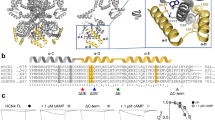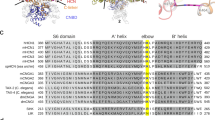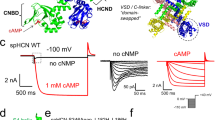Abstract
Hyperpolarization-activated cyclic nucleotide-modulated (HCN) channels are tetrameric membrane proteins that generate electrical rhythmicity in specialized neurons and cardiomyocytes. The channels are primarily activated by voltage but are receptors as well, binding the intracellular ligand cyclic AMP. The molecular mechanism of channel activation is still unknown. Here we analyze the complex activation mechanism of homotetrameric HCN2 channels by confocal patch-clamp fluorometry and kinetically quantify all ligand binding steps and closed-open isomerizations of the intermediate states. For the binding affinity of the second, third and fourth ligand, our results suggest pronounced cooperativity in the sequence positive, negative and positive, respectively. This complex interaction of the subunits leads to a preferential stabilization of states with zero, two or four ligands and suggests a dimeric organization of the activation process: within the dimers the cooperativity is positive, whereas it is negative between the dimers.
This is a preview of subscription content, access via your institution
Access options
Subscribe to this journal
Receive 12 print issues and online access
$259.00 per year
only $21.58 per issue
Buy this article
- Purchase on Springer Link
- Instant access to full article PDF
Prices may be subject to local taxes which are calculated during checkout







Similar content being viewed by others
References
Gauss, R., Seifert, R. & Kaupp, U.B. Molecular identification of a hyperpolarization-activated channel in sea urchin sperm. Nature 393, 583–587 (1998).
Ludwig, A., Zong, X., Jeglitsch, M., Hofmann, F. & Biel, M. A family of hyperpolarization-activated mammalian cation channels. Nature 393, 587–591 (1998).
Santoro, B. et al. Identification of a gene encoding a hyperpolarization-activated pacemaker channel of brain. Cell 93, 717–729 (1998).
Moosmang, S., Biel, M., Hofmann, F. & Ludwig, A. Differential distribution of four hyperpolarization-activated cation channels in mouse brain. Biol. Chem. 380, 975–980 (1999).
Santoro, B. et al. Molecular and functional heterogeneity of hyperpolarization-activated pacemaker channels in the mouse CNS. J. Neurosci. 20, 5264–5275 (2000).
Chan, C.S., Shigemoto, R., Mercer, J.N. & Surmeier, D.J. HCN2 and HCN1 channels govern the regularity auf autonomous pacemaking and synaptic resetting in globus pallidus neurons. J. Neurosci. 24, 9921–9932 (2004).
Banks, M.I., Pearce, R.A. & Smith, P.H. Hyperpolarization-activated cation current (Ih) in neurons of the medical nucleus of the trapezoid body: voltage-clamp analysis and enhancement by norepinephrine and cAMP suggest a modulatory mechanism in the auditory brain system. J. Neurophysiol. 70, 1420–1432 (1993).
Cuttle, M.F., Rusznak, Z., Wong, A.Y., Owens, S. & Forsythe, I.D. Modulation of a presynaptic hyperpolarization-activated cationic current (Ih) at an excitory synaptic terminal in the rat auditory brain stem. J. Physiol. (Lond.) 534, 733–744 (2001).
Ingram, S.L. & Williams, J.T. Modulation of the hyperpolarization-activated current (Ih) by cyclic nucleotides in guinea-pig primary afferent neurons. J. Physiol. (Lond.) 492, 97–106 (1996).
Saitow, F. & Konishi, S. Excitability increase induced by beta-adrenergic receptor-mediated activation of hyperpolarization-activated cation channels in rat cerebellar basket cells. J. Neurophysiol. 84, 2026–2034 (2000).
Notomi, T. & Shigemoto, R. Immunohistochemical localization of Ih channel subunits, HCN1–4, in the rat brain. J. Comp. Neurol. 471, 241–276 (2004).
Brown, H.F., DiFrancesco, D. & Noble, S.J. How does adrenaline accelerate the heart? Nature 280, 235–236 (1979).
Ludwig, A. et al. Two pacemaker channels from human heart with profoundly different activation kinetics. EMBO J. 18, 2323–2329 (1999).
Gauss, R. & Seifert, R. Pacemaker oscillations in heart and brain: a key role for hyperpolarization-activated cation channels. Chronobiol. Int. 17, 453–469 (2000).
Biel, M., Wahl-Schott, C., Michalakis, S. & Zong, X. Hyperpolarization-activated cation channels: from genes to function. Physiol. Rev. 89, 847–885 (2009).
DiFrancesco, D. Characterization of single pacemaker channels in cardiac sino-atrial node cells. Nature 324, 470–473 (1986).
Santoro, B. & Tibbs, G.R. The HCN gene family: molecular basis of the hyperpolarization-activated pacemaker channels. Ann. NY Acad. Sci. 868, 741–764 (1999).
DiFrancesco, D. Dual allosteric modulation of pacemaker (f) channels by cAMP and voltage in rabbit SA node. J. Physiol. (Lond.) 515, 367–376 (1999).
Wang, J., Chen, S. & Siegelbaum, S.A. Regulation of hyperpolarization-activated HCN channel gating and cAMP modulation due to interactions of COOH terminus and core transmembrane regions. J. Gen. Physiol. 118, 237–250 (2001).
Wang, J., Chen, S., Nolan, M.F. & Siegelbaum, S.A. Activity-dependent regulation of HCN pacemaker channels by cyclic AMP: signaling through dynamic allosteric coupling. Neuron 36, 451–461 (2002).
Robinson, R.B. & Siegelbaum, S.A. Hyperpolarization-activated cation currents: from molecules to physiological function. Annu. Rev. Physiol. 65, 453–480 (2003).
Craven, K.B. & Zagotta, W.N. CNG and HCN channels: two peas, one pod. Annu. Rev. Physiol. 68, 375–401 (2006).
Kaupp, U.B. & Seifert, R. Molecular diversity of pacemaker ion channels. Annu. Rev. Physiol. 63, 235–257 (2001).
Zagotta, W.N. et al. Structural basis for modulation and agonist specificity of HCN pacemaker channels. Nature 425, 200–205 (2003).
Altomare, C. et al. Integrated allosteric model of voltage gating in HCN channels. J. Gen. Physiol. 117, 519–532 (2001).
Bruening-Wright, A., Elinder, F. & Larsson, H.P. Kinetic relationship between the voltage sensor and the activation gate in spHCN channels. J. Gen. Physiol. 130, 71–81 (2007).
Männikkö, R., Pandey, S., Larsson, H.P. & Elinder, F. Hysteresis in the voltage dependence of HCN channels: conversion between two modes affects pacemaker properties. J. Gen. Physiol. 125, 305–326 (2005).
Elinder, F., Männikkö, R., Pandey, S. & Larsson, H.P. Mode shifts in the voltage gating of the mouse and human HCN2 and HCN4 channels. J. Physiol. (Lond.) 575, 417–431 (2006).
Craven, K.B. & Zagotta, W.N. Salt bridges and gating in the COOH-terminal region of HCN2 and CNGA1 channels. J. Gen. Physiol. 124, 663–677 (2004).
Shin, K.S., Maertens, C., Proenza, C., Rothberg, B.S. & Yellen, G. Inactivation in HCN channels results from reclosure of the activation gate: desensitization to voltage. Neuron 41, 737–744 (2004).
Ulens, C. & Siegelbaum, S.A. Regulation of hyperpolarization-activated HCN channels by cAMP through a gating switch in binding domain symmetry. Neuron 40, 959–970 (2003).
Chen, S., Wang, J., Zhou, L., George, M.S. & Siegelbaum, S.A. Voltage sensor movement and cAMP binding allosterically regulate an inherently voltage-independent closed-open transition in HCN channels. J. Gen. Physiol. 129, 175–188 (2007).
Kusch, J. et al. Interdependence of receptor activation and ligand binding in HCN2 pacemaker channels. Neuron 67, 75–85 (2010).
Weiss, J.N. The Hill equation revisited: uses and misuses. FASEB J. 11, 835–841 (1997).
Colquhoun, D. Binding, gating, affinity and efficacy: the interpretation of structure-activity relationships for agonists and of the effects of mutating receptors. Br. J. Pharmacol. 125, 924–947 (1998).
Yifrach, O. Hill coefficient for estimating the magnitude of cooperativity on gating transitions of voltage-dependent ion channels. Biophys. J. 87, 822–830 (2004).
Monod, J., Wyman, J. & Changeux, J.P. On the nature of allosteric transitions: a plausible model. J. Mol. Biol. 12, 88–118 (1965).
Goulding, E.H., Tibbs, G.R. & Siegelbaum, S.A. Molecular mechanism of cyclic-nucleotide-gated channel activation. Nature 372, 369–374 (1994).
Biskup, C. et al. Relating ligand binding to activation gating in CNGA2 channels. Nature 446, 440–443 (2007).
DiFrancesco, D. & Tortora, P. Direct activation of cardiac pacemaker channels by intracellular cyclic AMP. Nature 351, 145–147 (1991).
Wainger, B.J., DeGennaro, M., Santoro, B., Siegelbaum, S.A. & Tibbs, G.R. Molecular mechanism of cAMP modulation of HCN pacemaker channels. Nature 411, 805–810 (2001).
Liu, D.T., Tibbs, G.R., Paoletti, P. & Siegelbaum, S.A. Constraining ligand-binding site stoichiometry suggests that a cyclic nucleotide-gated channel is composed of two functional dimers. Neuron 21, 235–248 (1998).
Burzomato, V., Beato, M., Groot-Kormelink, P.J., Colquhoun, D. & Sivilotti, L.G. Single-channel behavior of heteromeric alpha1beta glycine receptors: an attempt to detect a conformational change before the channel opens. J. Neurosci. 24, 10924–10940 (2004).
Nache, V. et al. Activation of olfactory-type cyclic nucleotide-gated channels is highly cooperative. J. Physiol. (Lond.) 569, 91–102 (2005).
Jonas, P. High-speed solution switching using piezo-based micropositioning stages. in Single-Channel Recording (eds. Sakmann, B. & Neher, E.) 231–243 (Plenum Press, New York, 1995).
Zheng, J. & Zagotta, W.N. Gating rearrangements in cyclic nucleotide-gated channels revealed by patch-clamp fluorometry. Neuron 28, 369–374 (2000).
Zheng, J. & Zagotta, W.N. Patch-clamp fluorometry recording of conformational rearrangements of ion channels. Sci. STKE 2003, PL7 (2003).
Wu, S. et al. State-dependent cAMP binding to functioning HCN channels studied by patch-clamp fluorometry. Biophys. J. 100, 1226–1232 (2011).
Acknowledgements
We are indebted to U.B. Kaupp for providing the cDNA and to F. Lehmann (Dyomics GmbH, Jena, Germany) for providing the dyes. We would also like to thank G. Ditze, G. Sammler, F. Horn, M. Händel, K. Schoknecht, S. Bernhardt, A. Kolchmeier and B. Tietsch for excellent technical assistance. This work was supported by grants from the Deutsche Forschungsgemeinschaft (to K.B.) and from the Friedrich-Schiller-University (to J.K.). F.S. acknowledges support from the Bremen Innovation Agency.
Author information
Authors and Affiliations
Contributions
J.K. and S.T. designed and carried out the electrophysiological and fluorometrical measurements, analyzed the experimental data (apart from the global fit) and prepared the figures. J.K. also contributed to the manuscript preparation. E.S. performed the mathematical analysis of the experimental data. C.B. developed the software for analyzing the fluorometrical data. V.N. and R.S. contributed to the experimental design. T.Z. provided molecular biological support. F.S. synthesized the fluorescently labeled cAMP. K.B. planned the project, designed experiments and wrote the manuscript.
Corresponding author
Ethics declarations
Competing interests
The authors declare no competing financial interests.
Supplementary information
Supplementary Text and Figures
Supplementary Methods and Supplementary Results (PDF 211 kb)
Rights and permissions
About this article
Cite this article
Kusch, J., Thon, S., Schulz, E. et al. How subunits cooperate in cAMP-induced activation of homotetrameric HCN2 channels. Nat Chem Biol 8, 162–169 (2012). https://doi.org/10.1038/nchembio.747
Received:
Accepted:
Published:
Issue Date:
DOI: https://doi.org/10.1038/nchembio.747
This article is cited by
-
A high affinity switch for cAMP in the HCN pacemaker channels
Nature Communications (2024)
-
Kinetic fingerprinting of metabotropic glutamate receptors
Communications Biology (2023)
-
Fast functional mapping of ligand-gated ion channels
Communications Biology (2023)
-
Enlightening activation gating in P2X receptors
Purinergic Signalling (2022)
-
cAMP binding to closed pacemaker ion channels is non-cooperative
Nature (2021)



